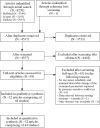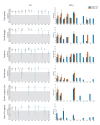The reliability of gait parameters captured via instrumented walkways: a systematic review and meta-analysis
- PMID: 34985239
- PMCID: PMC9987464
- DOI: 10.23736/S1973-9087.22.07037-X
The reliability of gait parameters captured via instrumented walkways: a systematic review and meta-analysis
Abstract
Introduction: Electronic pressure-sensitive walkways are commonly available solutions to quantitatively assess gait parameters for clinical and research purposes. Many studies have evaluated their measurement properties in different conditions with variable findings. In order to be informed about the current evidence of their reliability for optimal clinical and scientific decision making, this systematic review provided a quantitative synthesis of the test-retest reliability and minimal detectable change of the captured gait parameters across different test conditions (single and cognitive dual-task conditions) and population groups.
Evidence acquisition: A literature search was conducted in PubMed, Embase, and Scopus until November 2021 to identify articles that examined the test-retest reliability properties of the gait parameters captured by pressure-sensitive walkways (gait speed, cadence, stride length and time, double support time, base of support) in adult healthy individuals or patients. The methodological quality was rated using the Consensus-Based Standards for the Selection of Health Measurement Instruments Checklist. Data were meta-analyzed on intraclass correlation coefficient to examine the test-retest relative reliability. Quantitative synthesis was performed for absolute reliability, examined by the weighted average of minimal detectable change values.
Evidence synthesis: A total of 44 studies were included in this systematic review. The methodological quality was adequate in half of the included studies. The main finding was that pressure-sensitive walkways are reliable tools for objective assessment of spatial and temporal gait parameters both in single-and cognitive dual-task conditions. Despite few exceptions, the review identified intraclass correlation coefficient higher than 0.75 and minimal detectable change lower than 30%, demonstrating satisfactory relative and absolute reliability in all examined populations (healthy adults, elderly, patients with cognitive impairment, spinocerebellar ataxia type 14, Huntington's disease, multiple sclerosis, Parkinson's disease, rheumatoid arthritis, spinal cord injury, stroke or vestibular dysfunction).
Conclusions: Current evidence suggested that, despite different populations and testing protocols used in the included studies, the test-retest reliability of the examined gait parameters was acceptable under single and cognitive dual-task conditions. Further high-quality studies with powered sample sizes are needed to examine the reliability findings of the currently understudied and unexplored pathologies and test conditions.
Conflict of interest statement
Figures





References
-
- Baker R. Gait analysis methods in rehabilitation. J Neuroeng Rehabil 2006;3:4. https://www.ncbi.nlm.nih.gov/entrez/query.fcgi?cmd=Retrieve&db=PubMed&l... 10.1186/1743-0003-3-4 - DOI - PMC - PubMed
-
- Rispens SM, van Schooten KS, Pijnappels M, Daffertshofer A, Beek PJ, van Dieën JH. Identification of fall risk predictors in daily life measurements: gait characteristics’ reliability and association with self-reported fall history. Neurorehabil Neural Repair 2015;29:54–61. https://www.ncbi.nlm.nih.gov/entrez/query.fcgi?cmd=Retrieve&db=PubMed&l... 10.1177/1545968314532031 - DOI - PubMed
-
- Pistacchi M, Gioulis M, Sanson F, De Giovannini E, Filippi G, Rossetto F, et al. Gait analysis and clinical correlations in early Parkinson’s disease. Funct Neurol 2017;32:28–34. https://www.ncbi.nlm.nih.gov/entrez/query.fcgi?cmd=Retrieve&db=PubMed&l... 10.11138/FNeur/2017.32.1.028 - DOI - PMC - PubMed
-
- Liu B, Hu X, Zhang Q, Fan Y, Li J, Zou R, et al. Usual walking speed and all-cause mortality risk in older people: A systematic review and meta-analysis. Gait Posture 2016;44:172–7. https://www.ncbi.nlm.nih.gov/entrez/query.fcgi?cmd=Retrieve&db=PubMed&l... 10.1016/j.gaitpost.2015.12.008 - DOI - PubMed
-
- Chamberlin ME, Fulwider BD, Sanders SL, Medeiros JM. Does fear of falling influence spatial and temporal gait parameters in elderly persons beyond changes associated with normal aging? J Gerontol A Biol Sci Med Sci 2005;60:1163–7. https://www.ncbi.nlm.nih.gov/entrez/query.fcgi?cmd=Retrieve&db=PubMed&l... 10.1093/gerona/60.9.1163 - DOI - PubMed
Publication types
MeSH terms
LinkOut - more resources
Full Text Sources
Medical

